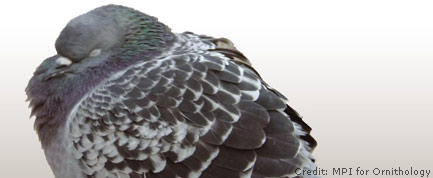Bird Brains: Pigeons Gamble Just Like Humans

If you had a choice, would you press a button that gave you an evenly spaced $3 per push, or would you choose the button with the big, but rare, payoff of $10 — even if that meant you got only $2 per push on average?
The answer may seem obvious, but anyone who gambles gives up a sure bet of money in their pocket in hopes of a big, unlikely win. Now, a new study finds that pigeons make similar bad choices.
The research, published Oct. 13 in the journal Proceedings of the Royal Society B, found that pigeons given the choice to peck a light that would give them three food pellets each time almost universally preferred a light that would give them a payout of 10 pellets 20 percent of the time. Averaged out, that meant pigeons were choosing to get two pellets per peck instead of three.
The reason could be that pigeons are motivated by a surprising change from their expectations, according to study author Thomas Zentall, a psychologist at the University of Kentucky. The same phenomenon could explain why human gamblers ignore their losses and focus on their rarer, but more surprising, wins.
Similar behaviors have been found in monkeys.
"It's a matter of expectation versus outcome," Zentall told LiveScience. "We learn from what is different from our expectations."
Will peck for food
Get the world’s most fascinating discoveries delivered straight to your inbox.
Human gambling behavior is complex, involving social interactions and all of the bells and whistles of casinos. Zentall and his colleagues used pigeons to strip all of that background away.
"We're trying to eliminate those motivational mechanisms and ask, 'Is there something more basic than that?'" he said.
To find out, he and his co-author trained eight pigeons to peck white lights for food. First, the hungry pigeons learned that if they pecked a certain light, say, the one on the right, they would see one of two colors, like yellow or blue (the colors and sides were switched for each pigeon to control for any biases by the birds). Ten seconds later, the pigeon would get three food pellets. This was roughly analogous to the sure thing of money in your pocket, Zentall said.
If the pigeon pecked the other light, say the one on the left, the light would flash either red or green. If red, the pigeons would get 10 pellets 10 seconds later. If green, the pigeons would get nothing. That light was the equivalent of taking a gamble.
After dozens of trials to learn what the lights meant, the pigeons did another round of trials to pick between lights. As it turned out, the birds acted like high rollers, picking the risky light with the 10-or-nothing outcome 82 percent of the time.
"The pigeon is getting 50 percent more food for choosing the right side, yet the pigeon chooses the left side almost 90 percent of the time," Zentall said.
Red light, go
Next, the researchers trained seven new pigeons on a slightly different task. This time, the blue and yellow light would still dispense three pellets regardless of color. But now, both the red and the green light had an 80 percent chance of dispensing nothing and a 20 percent chance of dispensing 10 pellets of food.
Those odds were the same as in the first experiment, but the birds weren't biting. In the second experiment, they preferred the sure thing of three pellets per peck.
The findings seem to suggest that the birds put undue weight on the excitement of the red light and subsequent food windfall, Zentall said. Evening out the odds on red and green takes away that excitement.
"When they pick the white light and they happen to get the red light, there's a huge change," he said. "'I kind of expect I might get fed — wow, I'm really getting a lot of food.'"
That upended expectation could stick out for the pigeons, influencing their decisions in future trials, he said.
Are pigeons like people?
"The idea that you could set up a situation in which a pigeon or any organism would reliably work against its own best interest is always inherently interesting," said Jeffrey Weatherly, a University of North Dakota psychologist who studies human gambling. However, Weatherly, who was not involved in the current study, questions whether animal studies can truly recreate human behavior.
"There has to be a commodity that gets lost. You have to be able to go into debt," Weatherly said. "It's difficult to simulate that with an animal model."
Zentall said that the beauty of his work is that it mirrors human gambling without all the baggage that comes with being human. That suggests a more basic motivation at play, he said. For example, animals that take risks in the wild may find themselves better off. Going out of your way for a couple of berries, for example, could lead you to a whole patch. In the controlled environment of a lab or casino, however, the risk-taking backfires.
Zentall also noted that his work has shown several parallels between animal and human gambling. For example, pigeons that live in enriched environments make less risky choices, he said, which matches human studies finding that people who are satisfied with their lives also tend to gamble less than those who are dissatisfied. And hungry pigeons, like people with less money, tend to gamble more, he said, despite the obvious downsides of taking risks when you have more to lose.
- Amazing Animal Abilities
- Understanding the 10 Most Destructive Human Behaviors
- Why We Gamble: The Enticement of Almost Winning

Stephanie Pappas is a contributing writer for Live Science, covering topics ranging from geoscience to archaeology to the human brain and behavior. She was previously a senior writer for Live Science but is now a freelancer based in Denver, Colorado, and regularly contributes to Scientific American and The Monitor, the monthly magazine of the American Psychological Association. Stephanie received a bachelor's degree in psychology from the University of South Carolina and a graduate certificate in science communication from the University of California, Santa Cruz.
